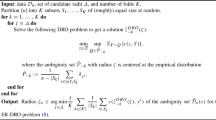Abstract
A decentralized sequential detection problem is considered where a set of sensors making independent observations must decide which of the given two hypotheses is true. Decision errors are penalized through a common cost function, and each time step taken by the sensors as a team is assigned a positive cost. It is shown that optimal sensor decision functions can be found in the class ofgeneralized sequential probability ratio tests (GSPRTs) with monotonically convergent thresholds. A technique is presented for obtaining the optimal thresholds. The performance of the optimal policy is compared with that of a policy which uses SPRTs at each of the sensors.
Similar content being viewed by others
References
M. M. Al-Ibrahim and P. K. Varshney, A simple multi-sensor sequential detection procedure,Proceedings of the 27th IEEE Conference on Decision and Control, Austin, TX, 1988, pp. 2479–2483.
D. Bertsekas,Dynamic Programming, Prentice-Hall, Englewood Cliffs, NJ, 1987.
H. R. Hashemi and I. B. Rhodes, Decentralized sequential detection,IEEE Trans. Inform. Theory,35 (1989), 509–520.
A. La Vigna, A. M. Makowski, and J. S. Baras, A continuous-time distributed version of Wald's sequential hypothesis testing problem,Proceedings of the 7th International Conference on Analysis and Optimization of Systems, Antibes (A. Bensoussan and J. L. Lions, eds.), Springer-Verlag, New York, 1986, pp. 533–543.
E. L. Lehmann,Testing Statistical Hypotheses, Wiley, New York, 1959.
D. Siegmund,Sequential Analysis: Tests and Confidence Intervals, Springer-Verlag, New York, 1985.
A. G. Tartakovskii. Sequential testing of many simple hypotheses with independent observations.Problems Inform. Transmission,24 (1988), 299–309.
D. Teneketzis and Y. C. Ho, The decentralized Wald problem,Inform, and Comput.,73 (1987), 23–44.
J. N. Tsitsiklis, On threshold rules in decentralized detection,Proceedings of the 25th IEEE Conference on Decision and Control, Athens, 1986, pp. 232–236.
J. N. Tsitsiklis, Decentralized detection, inAdvances in Statistical Signal Processing, vol. 2 (H. V. Poor and J. B. Thomas, eds.), JAI Press, Greenwich, CT, 1993.
V. V. Veeravalli, T. Başar, and H. V. Poor, The decentralized Wald problem with a nonlinear penalty on stopping times,Proceedings of the 25th Annual Conference on Information Sciences and Systems, Johns Hopkins University, Baltimore, MD, 1991, pp. 277–282.
V. V. Veeravalli, T. Başar, and H. V. Poor, Decentralized sequential detection with a fusion center performing the sequential test,IEEE Trans. Inform. Theory,39 (1993), 433–442.
A. Wald,Sequential Analysis, Wiley, New York, 1947.
M. Woodroofe,Nonlinear Renewal Theory in Sequential Analysis, SIAM, Philadelphia, PA, 1982.
Author information
Authors and Affiliations
Additional information
This research was supported in part by the Joint Services Electronics Program under Grant N00014-90-J-1270, through the University of Illinois.
Rights and permissions
About this article
Cite this article
Veeravalli, V.V., Başar, T. & Vincent Poor, H. Decentralized sequential detection with sensors performing sequential tests. Math. Control Signal Systems 7, 292–305 (1994). https://doi.org/10.1007/BF01211521
Received:
Issue Date:
DOI: https://doi.org/10.1007/BF01211521




